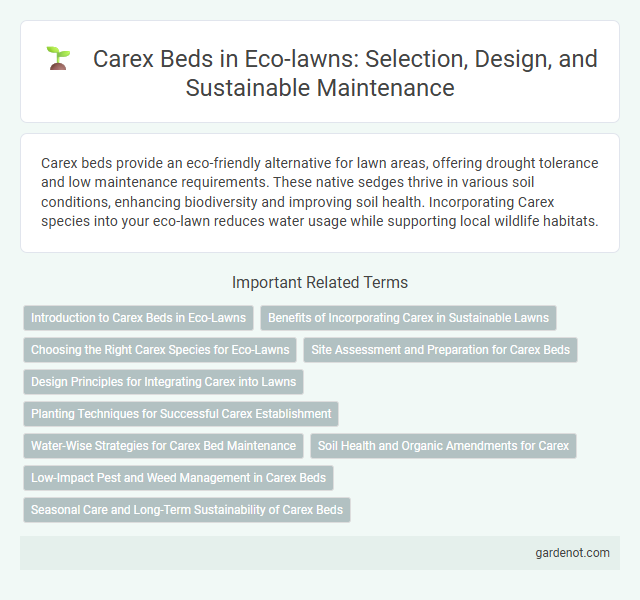Carex beds provide an eco-friendly alternative for lawn areas, offering drought tolerance and low maintenance requirements. These native sedges thrive in various soil conditions, enhancing biodiversity and improving soil health. Incorporating Carex species into your eco-lawn reduces water usage while supporting local wildlife habitats.
Introduction to Carex Beds in Eco-Lawns
Carex beds in eco-lawns provide sustainable groundcover with low water requirements and high adaptability to various soil types. These sedge species enhance biodiversity by supporting pollinators and improving soil health through their dense root systems. Their maintenance involves minimal mowing and no fertilizers, aligning with eco-friendly landscaping practices.
Benefits of Incorporating Carex in Sustainable Lawns
Carex species enhance sustainable lawns by improving soil stability and reducing erosion due to their dense root systems. These low-maintenance plants require minimal watering and fertilizer, promoting water conservation and reducing chemical runoff. Incorporating Carex in eco-lawns supports biodiversity by providing habitat for beneficial insects and wildlife.
Choosing the Right Carex Species for Eco-Lawns
Selecting the appropriate Carex species for eco-lawns involves evaluating factors such as soil type, moisture levels, and sunlight exposure to ensure optimal growth and sustainability. Species like Carex pennsylvanica thrive in dry, shaded environments, while Carex elata suits wet, sunny areas, making them ideal for diverse lawn conditions. Incorporating native Carex varieties enhances biodiversity, reduces maintenance needs, and supports local ecosystems in eco-lawn landscapes.
Site Assessment and Preparation for Carex Beds
Site assessment for Carex beds involves evaluating soil pH, moisture levels, and sunlight exposure to ensure optimal growing conditions. Proper preparation includes clearing existing vegetation, amending soil with organic matter to improve drainage, and leveling the area to prevent waterlogging. Selecting a location with partial shade and consistently moist, well-drained soil enhances the establishment and health of Carex plants in eco-lawn designs.
Design Principles for Integrating Carex into Lawns
Design principles for integrating Carex into lawns emphasize creating naturalistic, textured contrasts that enhance biodiversity and soil health. Selecting shade-tolerant, moisture-loving Carex species ensures adaptability within varied lawn conditions, while strategic planting patterns maintain visual balance and prevent invasive spread. Incorporating Carex beds reduces maintenance needs and supports native pollinators, promoting sustainable and eco-friendly lawn ecosystems.
Planting Techniques for Successful Carex Establishment
Planting Carex successfully requires well-prepared soil with good drainage and consistent moisture during establishment. Space Carex plugs or seedlings 12 to 18 inches apart to allow for natural spreading and air circulation, promoting vigorous growth. Mulching with organic material helps retain soil moisture and suppress weeds, ensuring a healthy and dense Carex bed over time.
Water-Wise Strategies for Carex Bed Maintenance
Carex beds thrive with efficient water-wise strategies such as deep, infrequent watering to encourage strong root development and enhance drought tolerance. Implementing mulch around Carex plants reduces evaporation and conserves soil moisture, promoting healthier growth with less water input. Selecting drought-resistant Carex varieties further optimizes water conservation while maintaining vibrant, resilient landscaping.
Soil Health and Organic Amendments for Carex
Carex beds thrive in well-drained, nutrient-rich soils that support robust root development and microbial activity, essential for soil health. Incorporating organic amendments such as compost, aged manure, or leaf mold enhances soil structure, moisture retention, and nutrient availability, promoting sustainable growth. Regular applications of these organic materials increase soil organic matter, fostering beneficial soil organisms and improving overall ecosystem resilience within Carex plantings.
Low-Impact Pest and Weed Management in Carex Beds
Implementing low-impact pest and weed management in Carex beds involves using organic mulches and manual weed removal to maintain soil health and reduce chemical reliance. Introducing beneficial insects such as ladybugs and predatory mites helps control pests naturally, preserving the ecological balance within the Carex habitat. Regular monitoring combined with targeted, minimal intervention ensures the sustainable growth of Carex without compromising the surrounding ecosystem.
Seasonal Care and Long-Term Sustainability of Carex Beds
Seasonal care for Carex beds involves regular trimming in early spring to remove winter debris and promote fresh growth, while maintaining optimal moisture levels during dry summer months ensures resilience against drought stress. Long-term sustainability of Carex beds is achieved through selective thinning every few years to prevent overcrowding and the application of organic mulch to improve soil structure and retain moisture. Integrating native Carex species enhances biodiversity and supports local ecosystems, fostering a durable, eco-friendly lawn alternative.
Carex bed Infographic

 gardenot.com
gardenot.com